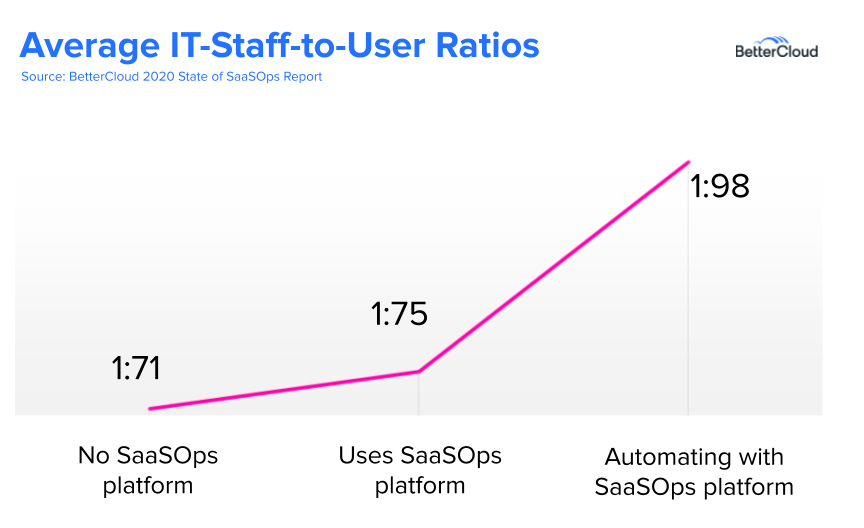4 Signs You’re Ready to Automate With a SaaSOps Platform
August 21, 2020
5 minute read

If your enterprise IT team is like others right now, your already stretched department is looking at new budget cuts. You’ve concluded that you need to rethink how IT manages users and SaaS applications to thrive in this new era of IT. Time to consider ways to improve your operational efficiency, like automation. After all, there are big automation benefits. But how does an enterprise know where to start? And how does an enterprise team know when to automate IT and start using a SaaS operations (SaaSOps) platform?
Here we’ll take a look at two things. One, we’ll quickly examine the big IT automation benefits. And two, we’ll explore our annual survey’s insights on the four signs that point to when to automate SaaS operations.
5 big IT automation benefits
You’ve probably heard them before, but it bears reinforcing, particularly in regards to SaaS. By automating, every IT team and organization gains. Specifically, you can expect:
- Lower error. Achieve complete consistency at scale, which is impossible for even the very best IT professional.
- Improved security. Raise security levels because there’s fewer mistakes.
- Quicker operations. Get work done faster.
- Measurable savings. Eliminate laborious, boring, manual work to deliver cost and time savings and instead focus on higher value IT tasks.
- Better end user experience. Improve satisfaction and productivity among the entire organization.
So ask yourself: Which of the big IT automation benefits would best help your organization? And what would fewer mistakes and better security mean to your company? What could you do with the time saved by trading in the manual work?
But knowing when to automate—when it’s time to build that first workflow—is hard. Fortunately, some insights from our recent research can show the way.
4 signs to help you decide when to automate
Earlier this year, we fielded a survey to get insights into SaaS environments and SaaSOps practices across a wide range of organizations. This is a sneak peek of what we learned from nearly 700 IT and security professionals—here’s how to tell when it’s time to automate.
1. Your enterprise has a lot of users or uses a lot of SaaS apps.
The need to automate—to improve manageability of your digital workplace—is generally driven by scale. And that scale is either a lot of SaaS apps, a lot of users, or a lot of both.
The next question, then, is: What’s a lot?
For organizations of all sizes, our recent research finds that the average digital workplace in 2020 uses around 80 SaaS apps. Obviously, large enterprises have more users. And more users will generally mean more SaaS apps.
Managing SaaS is a challenge of scale. Say you’re an enterprise with 500 users using only a cloud productivity suite. You’re managing scale. Add another user, and another and another, and that challenge grows. Each user creates more and more data. And with each SaaS app that an enterprise adds, SaaS management grows into a bigger and bigger challenge.
So, the truth is, organizations with more than 500 employees using only a single SaaS app will still benefit from a SaaSOps platform. And by the time a large enterprise is using more than a handful, it’s a signal of when to automate. When a large organization uses about 30 apps, they’ll already rely on automating their SaaS operations.
Now what if your organization has less than 500 employees?
The averages for these smaller companies provide some logical indicators that point to when to automate. Our research shows if you have fewer than 20 apps, you can probably get by with native admin consoles and scripting. But once you’re above that number, it’s time for a SaaSOps platform to ease management.
When you get to about 33 apps, your IT needs those big automation benefits and should be actively working to automate SaaS management and security. After all, it’s hard to scale and add more SaaS apps without it.
Layer on file security needs, compliance requirements, or audit log requirements, and you can expect to need automation sooner—or, alternatively, you’ll need a bigger IT team to manage and secure everything.
2. Your IT-staff-to-user ratio shows inefficiencies.
One of the big IT automation benefits is that it helps you get more work done. So automation naturally means you can have a single IT professional serving a higher number of users. And our research results are perfectly consistent with this expectation.
On average, our research shows that SaaSOps users generally have 1 IT staffer serving 75 users, while non-SaaSOps users have 1 staffer serving 71 users, and SaaSOps users that automate have 1 IT team member for every 98 users.

Note, though, this is the average of all organizations where larger ones generally have scale. However, we see the same pattern in smaller companies. If your team needs to serve a growing number of users with the same sized staff, it can indicate when to automate.
3. The majority (over 50%) of your organization’s apps are SaaS-based.
Our research shows that most organizations whose majority of apps are SaaS, e.g., greater than 50%, are already using a SaaSOps platform. If you’re still rapidly adopting SaaS, by the time you’re about 70% SaaS, you’ll be using automated workflows on that platform.
4. Your IT team spends too much time on user offboarding.
According to a recent Forrester consulting study for BetterCloud, and confirmed by our research, organizations spend about 7 hours offboarding a single user from all SaaS apps. If you’re spending this kind of time using a painstakingly slow and error-prone manual process, it signals when to automate with a SaaSOps platform.
With automation, you can offboard a user anywhere from 4 to 18 times faster—resulting in a process that’s significantly more efficient and secure.
Start now and reap big IT automation benefits
Now that you know when to automate, getting started on your automation journey requires a strategy. You need to identify the process you’re going to automate. If you’re having trouble, there’s a good rule of thumb—and it’s the rule of “three.”
Think about tasks an IT professional must do more than three times per month. Which tasks are most time consuming? Here is your starting point.
As any IT automation veteran will tell you, building effective automation is a process of refinement. Don’t expect perfection at first. Build your workflows and aim for continuous improvement. Just start, and soon, the big IT automation benefits will be yours.
Ready? Get started by reviewing our Help Center articles on workflows or learning more about our new Workflow Templates. You can also sign up for BetterIT, the #1 community for modern IT pros, to get new automation ideas and talk tech. Join the convo here!
Considering a SaaSOps solution? Check out our 2020 SaaSOps Buyer’s Guide to learn how to select the right platform for your organization. You’ll get a deep dive into key use cases, product features, technical capabilities to consider, and more.






